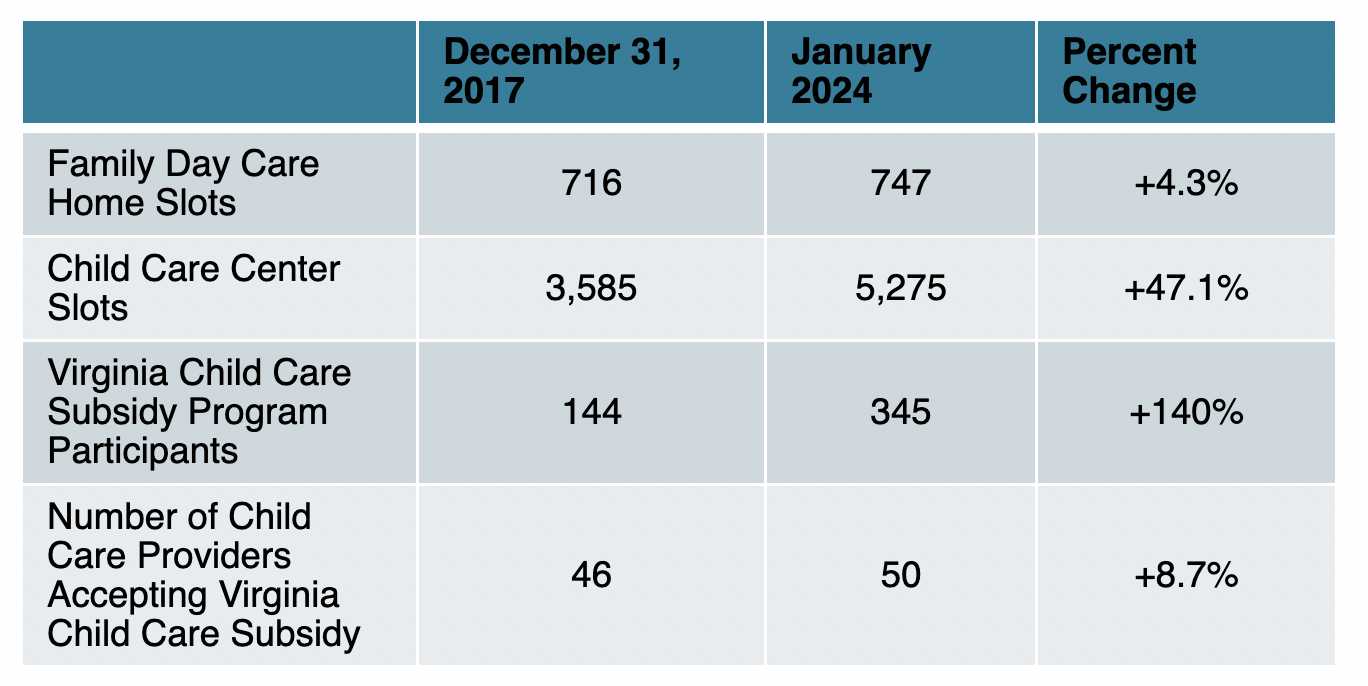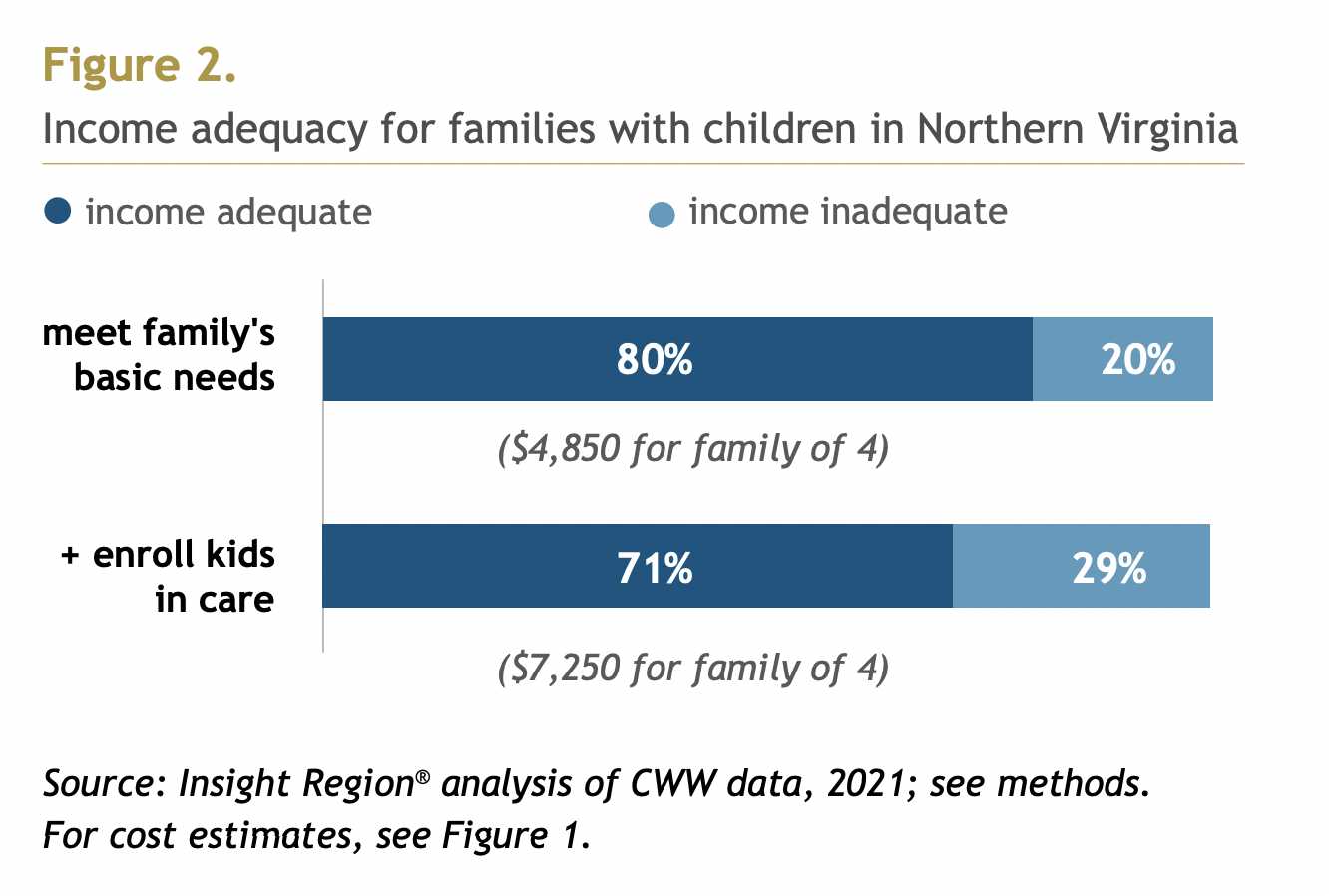
An uptick in childcare centers in Arlington has made a dent in the local care shortage, according to new county data.
Since 2017, the number of childcare center slots increased by 47%, or 1,690 slots. That may be good news for tackling low availability in Arlington — which stands out among Northern Virginia neighbors for how few slots it has — but one shortage remains.
The county tells ARLnow that too few providers today accept state subsidies, affecting how many low-income families can access high-quality childcare.
“Although the county has seen a substantial increase in child care center slots and a slight increase in the number of family day care home slots in Arlington since December 2017, there has only been a modest increase in the number of child care providers accepting the Virginia Child Care Subsidy,” county spokesman Ryan Hudson said in a statement.
“This modest increase has most definitely not kept pace with the increase in the number of Virginia Child Care Subsidy Program participants during the same timeframe,” he continued.
Arlington County partially attributes the uptick in daycare centers to zoning code and review process reforms to make it easier to approve private child-care services. Those improvements, used by all county planners today, “have helped child care providers and increased child care availability in Arlington,” the county says.
But the uptick in slots pales in comparison to the number of families participating in a state subsidy program, who are vying for a small pool of slots, as not all providers accept such subsidies. Those that do typically reserve few slots for participating families.

This is not a new problem for Arlington or Virginia, which recently ranked in the bottom half of American states and territories for the number of providers that accept subsidies.
Seven years ago, the county found that providers could serve half of Arlingtonians under 5 years old, with childcare centers making up half of Arlington’s overall capacity. Subsidized slots made up 2-23% of that capacity, varying by provider, compared to the 33% subsidy acceptance rate on average for home-based daycares.
That discrepancy is still true today and the providers cite several reasons for not participating.
These include “the complicated nature of reimbursement and reporting requirements, the cost of child care being much greater than the Virginia Child Care Subsidy Program’s Maximum Reimbursement Rates, and the fact that there is no operational need to accept the Virginia Child Care Subsidy when child care programs are already full and operating with waitlists,” Hudson said.
Arlington County is looking to help alleviate these concerns with a new program backed by $5 million in local funding. In December, it issued a “Notice of Funding Availability,” or NOFA, advertising $4.5 million available to applicants who bring forward “capital-oriented proposals that expand access to affordable, quality child care on a sustainable, multi-year basis.”
“Proposals should increase affordability in exchange for assistance with capital costs such as facility acquisition or expansion, buy-down of rent or mortgage costs, or investment in furniture, fixtures, or equipment,” the county said, noting the remaining half-million will provide smaller-scale assistance to providers in the future.
The application window closes at the end of this month and the county expects to select applicants in April.
Without subsidies, childcare eats up a significant chunk of the average Northern Virginia family’s monthly budget, a recent report found. Almost a third of families in the region, and more than 40% in South Arlington, are unable to cover their basic needs and pay the going rate for childcare.
Childcare-related budget pressures hold true for even “lower-middle class” Arlingtonians, relatively speaking — those with a household income of $100,000-$150,000 — about one in five of whom reportedly do not have the income to cover childcare.
The NOFA is the most recent effort to come out of Arlington’s Child Care Initiative, or CCI, launched in 2017 to study availability and make it easier to connect families to providers. In addition to this work, the Dept. of Human Services has about $73,000 to spend each year in local childcare subsidy dollars.
The last CCI progress report came out five years ago and the county recently hired a new staff member to revisit the initiative starting this year. Still, the county says it has kept busy.
Last year, it requested proposals, now under review, for a new child care licensing system intended to “provide greater functionality related to licensing, inspections, and availability of child care slots.”
Four years ago, it established a virtual credentialing program out of the Arlington Employment Center, in addition to offering access to online credentialing courses to all licensed county providers. Around that time, with a $200,000 donation from Rosslyn-based Nestlé USA, the CCI developed a privately-funded scholarship program to support children whose families earn below the 30% area median income and who cannot get state subsidies.
Beyond the annual local supplement to state subsidies, amounting to about a half-million dollars since the start of CCI, Arlington County’s spending on improving childcare access has been tied to new hires to support the initiative and help meet state mandates, as well as a one-time childcare zoning consultant — $75,000 in the 2023 fiscal year.
This includes an associate planner ($115,698 in FY 2018), the assistant handling the future of the CCI ($180,000 in FY 2024) and a childcare specialist ($102,414 in FY 2024) who handles preschool classroom observations. These are now mandated by the state for assuring the quality of early learning programs that are publicly funded or receive state subsidies.
Photo via BBC Creative/Unsplash


